No excuses. Be somewhere Sept. 30 to toast the life and work of Michael Jackson. Make a donation to the National Parkinson Foundation.
The Beer Hunter website has all the information. If your local pub doesn’t have plans, doesn’t know about it then get involved and get a pub involved. The site has posters, information about donating to NPF and more. Got a website? A blog? Grab one of the banners (like this one) and help promote this toast.

I don’t have to tell you why, do I? If so I refer you to the links at The Beer Hunter or Jay Brooks’ well-kept list.
And then two posts you might have missed I think you shouldn’t. Maggie Dutton – whose blog, The Wine Offensive, is one of my regular reads – wrote a wonderful piece for Seattle Weekly.
She offers a different perspective and rightfully includes Charles Finkel, one of Michael’s co-conspirators. She chats with Charles, who tells her, “There’s beer before Michael Jackson and beer after Michael Jackson.”
Also give Martyn Cornell’s (The Zythophile) remembrance some time. The year was 1988 and “Jackson, even then probably the most famous beer writer on the planet, would be joining us later: he was flying in from judging at a beer festival in Finland …
“I believed we all cheered ironically, while secretly thinking: ‘What a fantastic job!’ However, when Jacko did arrive, he immediately showed how hard-working he was: taking extensive notes on every beer, photographing those bottles he hadn’t already got pictures of, while the rest of us were happy just to slurp and trough.”
Did he ever quit working?
When I realize I have a shelf with nothing but books by Michael Jackson it’s pretty obvious he didn’t. We once kidded about adding a “Where’s Michael?” map at The Beer Hunter site, figuring it would look a little like NORAD tracking Santa Claus. It made me sad, sometimes mad, when the beer drinking public just didn’t get it.
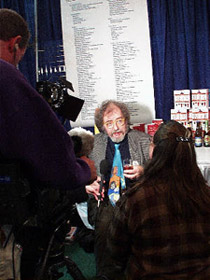 One example, from 2000 at the Great American Beer Festival. Michael had judged beers all day Wednesday, and in the evening spoke at a promotional event where he patiently posed with dozens of people for photos. He didn’t get back to his hotel until very late.
One example, from 2000 at the Great American Beer Festival. Michael had judged beers all day Wednesday, and in the evening spoke at a promotional event where he patiently posed with dozens of people for photos. He didn’t get back to his hotel until very late.
He checked his e-mail. There was important news. Samichlaus had been brewed again after a three-year hiatus. He tried to sleep, but couldn’t and was up in the middle of the night, putting together a “Notes from the road” column, firing it off to “rewrite@beerhunter.com” [please don’t try; the address is no longer active] so the scoop could be posted.
Then he put in another day of judging, arriving at the festival at 5:30 as it was opening. “Did you get my e-mail?” he asked (me).
I gulped. I hadn’t been near a computer all day.
We’d only managed to get the Internet connection in the hall working a few minutes before, but quickly collected his story, added a photo, and ran it through our database and publishing program. By the time he sat down to sign autographs the story nobody else had was on a computer screen in the booth.
More than 40 years after he first went to work for his hometown newspaper giving his readers the news first was still was mattered most.
He signed autographs more than three hours that evening, his only break coming when he did an interview for a TV film crew (above). He had no time to do what he loved, to wander around the hall and chat with brewers, always taking notes. He drank perhaps six ounces of beer the whole time, samples from when somebody would run off and retrieve beer for him.
If you ever had Michael sign an item for you, or watched him at work, you know that he’d speak several minutes with a perfect stranger. He never just dashed off a standard note and signed it “Michael Jackson.” He asked questions, just as much a reporter as when he had a notebook or tape recorder in hand. He wrote a personal message.
Not surprisingly, he was dead tired by the end of the evening and looked it. Yet he’d be up and judging the next morning and into the afternoon before rushing to another speaking event, a beer dinner and to the hall to sign books.
The next week a photo of Michael from that Thursday evening in the hall showed up via one of the beer e-mail lists I subscribe to. It was blurry (something most of us would blame on the camera or photographer). The person who sent the e-mail cleverly wrote that this is what Michael looked like “after a day of quote – work – end quote. Nice work if you can get it.”
This from from somebody who didn’t get it. You do. So be somewhere at 9 o’clock (Eastern) Sept 30. Raise your glass. Make a donation to NPF.
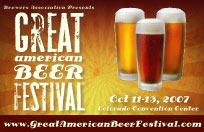 The drafting order is set for The Beer Mapping Project GABF Fantasy League, and I drew the 16th choice. beerinator cut off signups at 30 and the team (is that the right word?) with the last pick of the first round gets the first pick of the second. So in the second I’ll be drafting 15th. And so on until we’ve chosen hundreds of breweries.
The drafting order is set for The Beer Mapping Project GABF Fantasy League, and I drew the 16th choice. beerinator cut off signups at 30 and the team (is that the right word?) with the last pick of the first round gets the first pick of the second. So in the second I’ll be drafting 15th. And so on until we’ve chosen hundreds of breweries.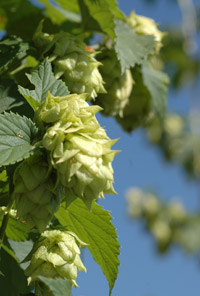
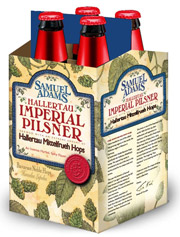 Back for a second time, Samuel Adams Hallertau Imperial Pilsner remains a beautiful — if big at 8.8% abv and 110 IBU — tribute to the Hallertau Mittelfrueh hop. Or Mittlefrüher as it is spelled in the Halltetauer region of Bavaria.
Back for a second time, Samuel Adams Hallertau Imperial Pilsner remains a beautiful — if big at 8.8% abv and 110 IBU — tribute to the Hallertau Mittelfrueh hop. Or Mittlefrüher as it is spelled in the Halltetauer region of Bavaria.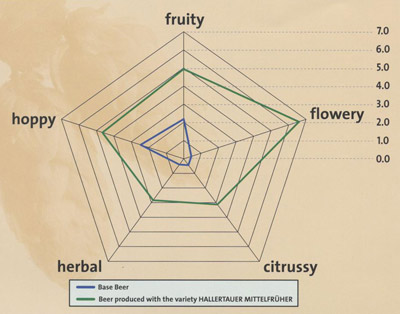


 One example, from 2000 at the Great American Beer Festival. Michael had judged beers all day Wednesday, and in the evening spoke at a promotional event where he patiently posed with dozens of people for photos. He didn’t get back to his hotel until very late.
One example, from 2000 at the Great American Beer Festival. Michael had judged beers all day Wednesday, and in the evening spoke at a promotional event where he patiently posed with dozens of people for photos. He didn’t get back to his hotel until very late.